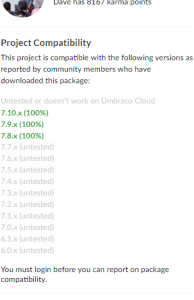Your website is a living and breathing entity that needs constant care and upkeep, and sites hosted on the Umbraco CMS are no different. While there are standard best practices to maintaining your Umbraco website, Umbraco offers numerous features and packages that require their own special love and tenderness. Our Umbraco developers have curated a list of essential Umbraco maintenance tips and best practices to ensure your website operates at peak performance, keeping it running smoothly and efficiently at all times.
1) Be On The Latest Version Of Umbraco
Staying on the latest version of Umbraco is a crucial best practice to ensure your website benefits from the newest features, security updates, and performance improvements. The most recent version, Umbraco 14, was released on May 30th, 2024, just five months after Umbraco 13's release. This rapid development cycle highlights the importance of being aware of new versions and promptly updating your site.
By keeping your website on the latest Umbraco version, you can leverage the latest cutting-edge features and ensure it remains secure and efficient. Additionally, upgrading to newer versions, and regular Umbraco maintenance, becomes simpler, minimizing potential disruptions.
Interested in learning more about the latest and greatest from Umbraco?
Check out our video overview of Umbraco 14.
2) Keep Umbraco Packages Up To Date
Umbraco and the Umbraco community offer numerous packages to help you run your Umbraco website more efficiently. Ranging in categories from E-commerce to SEO, security to CRMs, you’ll be able to add the Umbraco packages that have the greatest impact on your website performance and bottom line. Just like ensuring your website is on the most recent version of Umbraco, you should also make sure that your packages are tested on and compatible with the newest version of Umbraco.
You can check this by reviewing the Project Compatibility section on the package page:

3) Conduct Regular SEO Audits
Conducting regular SEO audits of your website is essential for maintaining peak performance and visibility. Establishing a consistent schedule of check-ins with your preferred SEO tools will help you monitor rankings, identify and fix page errors, and optimize overall site performance. By staying proactive, you can ensure your website remains competitive and provides an excellent user experience.
You’ll want to keep your eye on SEO site items like:
- Metadata
- Broken pages
- Broken internal links
- Broken images / media
- Tags
- Schema
- Blocking search engines
And more. If you're keeping a regular eye on these items, not only do you provide a great user experience, but you greatly increase your chances of enhancing your website’s organic visibility. Not sure where to start? There are tons of great SEO resources online, like these from Moz.
Also, our team of SEO experts and Umbraco Masters collaborated to create a few Umbraco SEO packages to get you started on keeping SEO tabs:
4) Run Scripts To Check Your Forms
Chances are you have forms or calls to action on your website that require a user to put in information to show they are interested in your services or products. Forms, like any functionality of a website, can sometimes break, or simply just not work the way they should. This can lead to missing purchase or lead information, but most importantly, it leads to a terrible user and brand experience. If a user gives up important information for your services and doesn’t receive a response or a product, this can cause friction and potential bad reviews.
At Marcel Digital, we highly recommend regularly testing your website’s forms to avoid this kind of friction. While not Umbraco specific, we use Ghost Inspector to help us test our partner’s website forms weekly, receiving email notifications if forms are not operating properly or having trouble submitting.
5) Perform Regular Security Audits and Updates
Maintaining robust security and compliance standards is a critical Umbraco best practice. Regular security audits are essential to identify and mitigate vulnerabilities before they can be exploited. Ensure you are consistently updating security plugins and patches to protect against new threats. Additionally, it's important to stay compliant with regulations such as GDPR, ensuring that your website handles user data responsibly and transparently. Implementing these practices will safeguard your site and build trust with your users.
6) Separate Your Umbraco Data (Media, Forms, Etc.) From The Umbraco Website
Basically, you have the run time which is the Umbraco website running with all of the files it needs to run, and then there are the data files, which is anything that has images, videos and form configurations. You want those separated so that you can move the website wherever you want and the data doesn’t have to go with it – but you can still access it from a different location. The benefit of doing this is really for deployments of Umbraco, where you can deploy a fresh copy with all of your updates each time, and you don’t have to worry about those files getting deleted and keeping them in sync with form configuration files. To separate our data, we use Azure Blob Containers in conjunction with the Umbraco Azure File System Provider package.
7) Optimize Website Performance for Faster Load Times
Optimizing the performance of your Umbraco website can significantly enhance user experience and improve search engine rankings. Implement effective caching strategies to reduce load times and improve responsiveness. Optimize images to ensure they load quickly without sacrificing quality, contributing to a faster overall site performance. Additionally, utilize Content Delivery Networks (CDNs) to distribute content more efficiently and reduce latency, ensuring your website is fast and reliable for users across the globe. By focusing on these performance optimization techniques, you can ensure your site runs smoothly and meets the demands of your audience.
8) Use uSync To Keep Umbraco Backoffice Data In Sync Across Environments
If you have Umbraco running in multiple environments, changes to data types, document types, etc., aren’t persistent across environments – such as your test, staging, and production websites. Without a way to keep these in sync, you have to manually go into each environment and replicate the changes each time. USync eliminates this by serializing that data into XML files, which can be carried from environment to environment in order to automate these changes for the user. If you’re using Umbraco Cloud to host your website, this is handled by Umbraco Deploy.
9) Hot Swap Deployments To Reduce Downtime
When you deploy an Umbraco instance, the application has to stop and be restarted to pick up the changes which have been deployed. This results in a small amount of site unresponsiveness for users while the site is being restarted. Using environment swapping, you can deploy the Umbraco to a staging environment and once that Umbraco instance is up and running, the staging and production environment can seamlessly swap, resulting in your users not experiencing an unresponsive website. At Marcel Digital, we leverage Microsoft Azure Cloud to perform this environment swapping for us.
10) Hire an Umbraco Expert to Ensure Peak Performance
Maintaining an Umbraco website requires continuous attention and expertise to keep it running at its best. At Marcel Digital, our team of Umbraco experts is dedicated to ensuring your site operates smoothly, securely, and efficiently. Partnering with Marcel Digital allows you to benefit from regular maintenance, timely updates, and proactive performance optimization, freeing you to focus on your core business activities. Let us handle the technical details and complexities, so you can enjoy a hassle-free, high-performing website.
Contact us today to learn more about our Umbraco maintenance services and how we can help you achieve optimal results.
Ready to start your project?
Let's chat. Fill out our form, and our team will be in touch with you shortly.

Web Development
About the author
Alex Vilmur
Alex Vilmur is a wizard at development and also trumpet. He once auditioned for The Mighty Mighty Bosstones, but found his passion for website development and Umbraco made it too hard to leave.